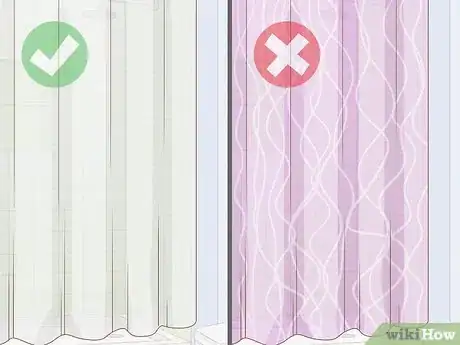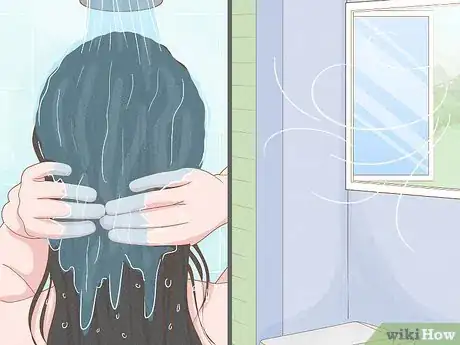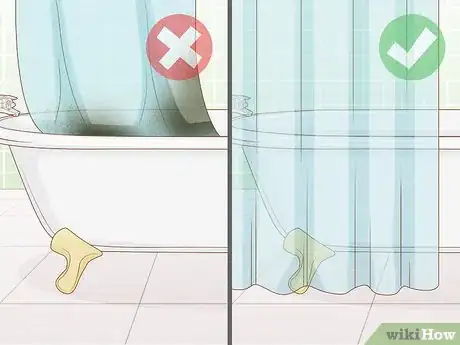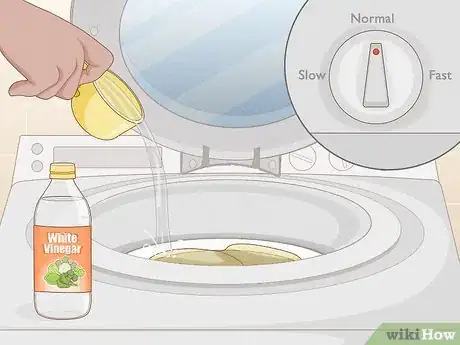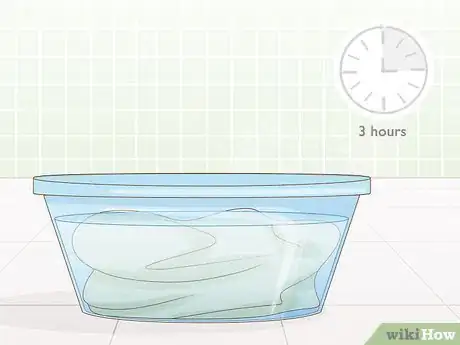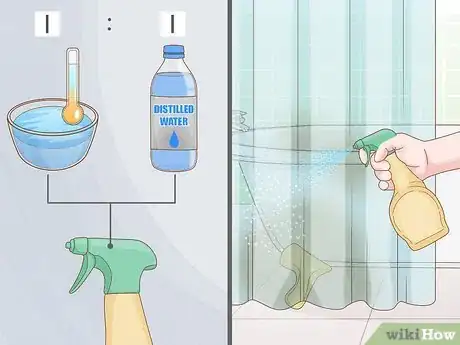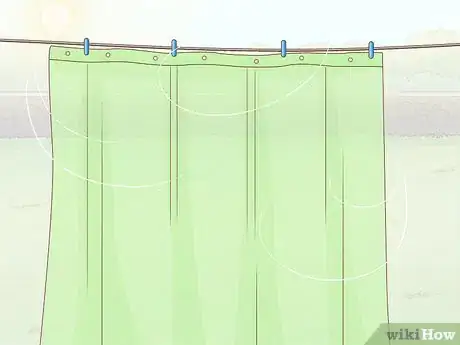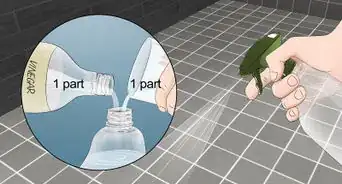This article was co-authored by Michelle Driscoll, MPH. Michelle Driscoll is the Owner of Mulberry Maids, which is based in Fort Collins, Colorado. With five years of experience, her business specializes in cleaning homes and small offices. She holds a Masters in Public Health from the Colorado School of Public Health. Additionally, Mulberry Maids has an A+ rating from the Better Business Bureau.
This article has been viewed 220,147 times.
Mildew growth on your shower curtain is mainly caused by moisture that remains after you shower or bathe. Although many people may discard their shower curtain and replace it with a fresh, new curtain or liner, there are preventative steps you can take on a regular basis to stop mildew growth before it occurs.
Steps
Avoiding Mildew
-
1Use a shower curtain or liner with a smooth, consistent surface. Shower curtains with raised or etched patterns may allow moisture or water to collect in certain areas; whereas a smooth curtain will allow water to glide down into the drain.[1]
-
2Ventilate your bathroom during and after your shower. This procedure will help your bathroom dry at a faster rate and help eliminate moisture buildup.[2]
- Open the window in your bathroom or turn on the ventilator fan to help remove excess moisture.
Advertisement -
3Open your shower curtain wide enough for air circulation. Once you get out of the shower, leave the curtain partially open. This will allow any trapped moisture on the wet side of the shower curtain to escape and dry faster.[3]
- Shake out the liner and separate any folds in your shower curtain to release trapped moisture.
- Also consider putting an empty laundry basket or a hook in the tub to hold the wet shower curtain away from the tub side.
-
4Hang the shower curtain on the outside of your bathtub. This will prevent mildew from forming on the area that clings to the tub.
- Move the shower curtain to the outside of the bathtub only after it has dried partially to prevent water from dripping onto your bathroom floor.
-
5Dry your shower curtain after each use. This will help prevent soap scum from forming on your shower curtain in addition to mildew.[4]
- Use a dry towel or rag to remove water from the wet side of your shower curtain after you shower.
Creating a Mildew Barrier
-
1Wash the curtain with detergent and vinegar. Put half the recommended amount of detergent in your washing machine. Add 1 cup (240 mL) of white vinegar. Toss in your shower curtain and a couple of old towels, and wash them on a normal cycle.[5]
-
2Fill your tub with water and 1 cup (300 g) of salt. Plug the drain and add the salt. Then, let the water run until it is deep enough to cover the curtain.[6]
-
3Let the curtain soak for 3 hours. Put your curtain in the tub and make sure it is fully submerged. Allow it to soak in the salt water solution. The salt water prevents mildew by creating a barrier on the shower curtain.[7]
-
4Air-dry the shower curtain. After 3 hours, take the curtain out of the tub. Avoid rinsing off the salt water. Hang up the curtain and let it dry before showering.[8]
Cleaning the Curtain
-
1Obtain or prepare a cleaning solution for your shower curtain. You can use a commercial bathroom-cleaning product that specializes in preventing mildew growth or make your own cleaning solution.
- If you use a commercial cleaning product, use the product as directed by the manufacturer.
- To make a natural cleaning solution, mix together 1 part warm water and 1 part distilled white vinegar and pour the mixture into a spray bottle.
- You can substitute bleach for vinegar; however, you will be required to properly ventilate your bathroom after using the bleach mixture to prevent adverse health effects from the toxic fumes.
-
2Clean your shower curtain at least once per week. This procedure will help disinfect your shower curtain and eliminate any bacteria that may contribute to the growth of mildew.[9]
- Spray your cleaning solution over the entire surface of your shower curtain.
- Use a clean, dry towel or rag to spread the cleaning solution over the entire surface of the shower curtain.
-
3Let the shower curtain air dry after cleaning it. Refrain from rinsing your shower curtain immediately after you have cleaned it to allow the properties from the solution to work completely.
Expert Q&A
Did you know you can get expert answers for this article?
Unlock expert answers by supporting wikiHow
-
QuestionHow do you get mold out of shower curtain liner?
 Michelle Driscoll, MPHMichelle Driscoll is the Owner of Mulberry Maids, which is based in Fort Collins, Colorado. With five years of experience, her business specializes in cleaning homes and small offices. She holds a Masters in Public Health from the Colorado School of Public Health. Additionally, Mulberry Maids has an A+ rating from the Better Business Bureau.
Michelle Driscoll, MPHMichelle Driscoll is the Owner of Mulberry Maids, which is based in Fort Collins, Colorado. With five years of experience, her business specializes in cleaning homes and small offices. She holds a Masters in Public Health from the Colorado School of Public Health. Additionally, Mulberry Maids has an A+ rating from the Better Business Bureau.
Founder, Mulberry Maids
-
QuestionAre shower curtain liners necessary?
 Michelle Driscoll, MPHMichelle Driscoll is the Owner of Mulberry Maids, which is based in Fort Collins, Colorado. With five years of experience, her business specializes in cleaning homes and small offices. She holds a Masters in Public Health from the Colorado School of Public Health. Additionally, Mulberry Maids has an A+ rating from the Better Business Bureau.
Michelle Driscoll, MPHMichelle Driscoll is the Owner of Mulberry Maids, which is based in Fort Collins, Colorado. With five years of experience, her business specializes in cleaning homes and small offices. She holds a Masters in Public Health from the Colorado School of Public Health. Additionally, Mulberry Maids has an A+ rating from the Better Business Bureau.
Founder, Mulberry Maids The shower curtain liner is best used to reduce water leakage out of your bathtub when you are showering. Typically, the cloth shower curtain is not waterproof but the liner is. In addition, the shower curtain liners help reduce wear on your fabric shower curtain. However, the ultimate choice is up to you and your preference.
The shower curtain liner is best used to reduce water leakage out of your bathtub when you are showering. Typically, the cloth shower curtain is not waterproof but the liner is. In addition, the shower curtain liners help reduce wear on your fabric shower curtain. However, the ultimate choice is up to you and your preference. -
QuestionHow do I stop mold from growing in my shower?
 Michelle Driscoll, MPHMichelle Driscoll is the Owner of Mulberry Maids, which is based in Fort Collins, Colorado. With five years of experience, her business specializes in cleaning homes and small offices. She holds a Masters in Public Health from the Colorado School of Public Health. Additionally, Mulberry Maids has an A+ rating from the Better Business Bureau.
Michelle Driscoll, MPHMichelle Driscoll is the Owner of Mulberry Maids, which is based in Fort Collins, Colorado. With five years of experience, her business specializes in cleaning homes and small offices. She holds a Masters in Public Health from the Colorado School of Public Health. Additionally, Mulberry Maids has an A+ rating from the Better Business Bureau.
Founder, Mulberry Maids Having proper ventilation is key to reducing the build-up of mold and mildew. If you have a bathroom fan, be sure to run it during your shower and for at least thirty minutes following your shower. In addition, if you have a window in your shower, it is also a good idea to shower with the window open, if possible. If you haven't checked your bathroom fan in a while, you can remove the cover and clean it out to help maximize the suction. In addition, you should leave your shower curtain or shower door partially open after using the shower to help release trapped moisture.
Having proper ventilation is key to reducing the build-up of mold and mildew. If you have a bathroom fan, be sure to run it during your shower and for at least thirty minutes following your shower. In addition, if you have a window in your shower, it is also a good idea to shower with the window open, if possible. If you haven't checked your bathroom fan in a while, you can remove the cover and clean it out to help maximize the suction. In addition, you should leave your shower curtain or shower door partially open after using the shower to help release trapped moisture.
Warnings
- If you use bleach to clean your shower curtain, avoid getting the mixture on any fabrics to prevent discoloration.⧼thumbs_response⧽
Things You'll Need
- Cleaning rag or towel
- Warm water
- Distilled white vinegar
- Spray bottle
- Salt
- Commercial bathroom cleaner (optional)
- Empty laundry basket (optional)
References
- ↑ https://www.bhg.com/homekeeping/house-cleaning/tips/how-to-prevent-mold-and-mildew/
- ↑ https://www.goodhousekeeping.com/home/cleaning/tips/a22126/prevent-mildew/
- ↑ https://www.thriftyfun.com/Preventing-Mildew-on-a-Shower-Curtain-5.html
- ↑ https://www.bhg.com/homekeeping/house-cleaning/tips/how-to-prevent-mold-and-mildew/
- ↑ http://tiphero.com/wash-shower-curtain-with-salt/
- ↑ http://tiphero.com/wash-shower-curtain-with-salt/
- ↑ http://tiphero.com/wash-shower-curtain-with-salt/
- ↑ http://tiphero.com/wash-shower-curtain-with-salt/
- ↑ https://brightnest.com/todos/properly-clean-your-shower-curtain-and-liner
About This Article
To prevent mildew on your shower curtain, let it air out whenever it gets wet. After you get out of the shower, leave your bathroom ventilator fan on for a while. This will help get rid of moisture from the curtain and reduce mildew. You should also leave the curtain partially open, so moisture doesn’t get trapped in the folds. Place the curtain on the outside of your tub to avoid mildew building up between the curtain and the tub. If you have time, wipe the curtain dry with a towel or rag after you shower. For more tips from our Cleaning co-author, including how to clean your shower curtain, read on.
